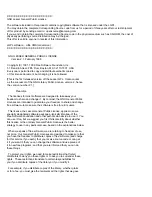
DDL Compiler Commands
Data Definition Language (DDL) Reference Manual — 426798-002
9- 42
DDL Command
DDL Command
The DDL command instructs the DDL compiler to:
•
Create and open a DDL source file or open an existing DDL output source file.
•
Translate any subsequent DDL object definitions in the source schema into DDL
source statements.
•
Translate any DDL objects specified in subsequent OUTPUT statements into DDL
source statements.
•
Write the DDL source statements to the DDL source file.
DDL
opens the specified source file, translates all subsequent DDL objects defined by
statements or output from the dictionary into DDL source format, and writes them
to the open DDL source file. If a DDL source file is already open, the command
closes the current file and opens a new source file.
ddl-source-file
identifies the DDL source file. If
ddl-source-file
is omitted, DDL lists the
source at the home terminal.
!
purges the contents of an existing DDL source file before opening the file. If the
specified file does not exist, DDL ignores the exclamation point.
NODDL
closes the currently open DDL source file and stops translating subsequent DDL
object definitions. NODDL is the default setting.
DDL Command Guidelines
The following points are guidelines for using the DDL command:
•
The compiler can translate DDL objects specified in an OUTPUT statement only if
the dictionary containing these structures is open.
•
Only one DDL source file can be open at a time. If you use the DDL command
when you already have a source file open, DDL closes the current source file
before opening the new source file.
•
If the DDL source file already exists and the exclamation point is omitted, DDL
appends the DDL object definitions to the end of the file’s original contents. DDL
does not replace any existing structures in the DDL source file.
{ DDL [ ddl-source-file [ ! ] ] | NODDL }
















































